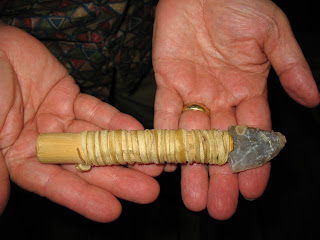
The problem with these knives is that they are very brittle and easily broken. For this reason most primitive knives, with the exception of a few ceremonial knives, did not look anything like these works of art. Most stone knives looked more like slightly lop-sided arrowheads.
A good example is the knife carried by the “Ice Man”, a late stone-age man who was found frozen in a glacier in the Italian Alps. The Ice Man knife had an overall length of five inches. It is described as looking like an “arrowhead” that has been wedged into a split wooden handle and secured with animal sinew. Pictured below: The Ice Man’s knife.

The Ice Man’s knife is not an exception but is, rather, the rule. There are hundreds of examples of these small stone knives that have been found at archeological sites around the world.
I have made a couple of these stone knives and have found that they work well. They are plenty sharp and pretty sturdy. Pictured below: A stone knife that I made.

But some of the most commonly used stone knives are overlooked because they look like nothing more than a flake of stone. If there is any flint, obsidian, chert, glass, or other knappable stone around, you can make a flake blade in seconds. It requires no tools, except another rock, and it requires no flint knapping skill. This makes the flake knife an ideal survival tool. And don’t think that a flake blade is a second rate tool. They are sharper than surgical stainless steel and can skin and butcher a deer as fast as any modern knife.
To make a flake blade you will need a fist size piece of flint and another rock to hit it with. Your striking stone, called a hammer stone, should not be flint because it will shatter. Most sandstone is not very good because it is too soft. I like to use a granite river rock. Sometimes they break, but they usually won’t shatter and throw rock splinters into your eyes. Needless to say when you are practicing this skill you should always wear safety glasses. Pictured below: Hammer stone and piece of flint.

Now, let’s make a flake blade. Hold the flint rock in one hand, then take the hammer stone in your other hand and strike down on the edge of the flint rock. With any luck a nice flake will pop off. Pictured below: top, striking the flint rock; bottom, resulting flake.


Be careful. The edge of this flake is sharper than a razor blade. Pictured below: Using a flake blade to slice meat.

The flake blade can be used to carve wood, but it is not as effective as a steel blade for this. The edge of the flake blade is extremely sharp but it is pretty fragile, and heavy whittling will likely cause the edge to crumble. For removing wood and shaping wood a flint flake is more often used as a scraper rather than a cutting blade.



3 comments:
hi, i wanted permission to use these pic in an article of mine on survival on www.squidoo.com
please reply about using them to
vamsikrishnachandrapati@gmail.com
I really like this blog about knife. Thanks for sharing with us great blog about knife.
Out The Front Knives
Good Morning,
I am interested in using some of your photos for a project at work. Would you be able to contact me at: samantha.eads@colorado.edu for specifics?
I appreciate your time and look forward to hearing from you!
Thanks!
Post a Comment